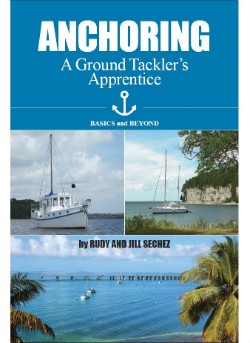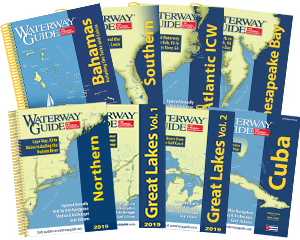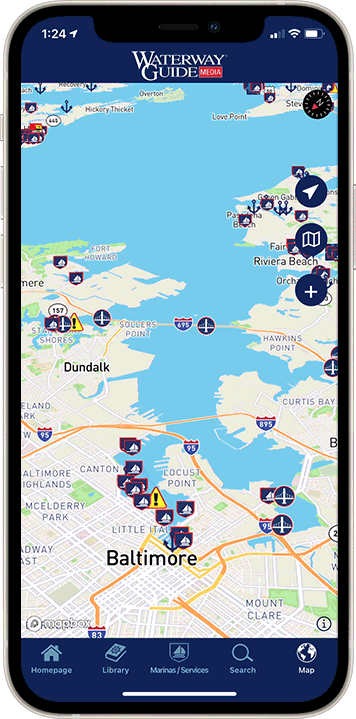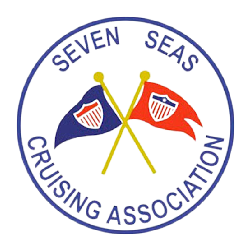Load tables are extremely useful; that's where you find the information on how strong to make your ground tackle−anchors, rope, chain, shackles, cleats, maybe even a swivel.
In order to pick items that meet minimum strength requirements, their strength rating−known as a Work Load Limit (WLL)−should meet or exceed the load generated by the highest wind speed that will be encountered. Take a look at the following Load Table:
Boat Size | Load on Ground Tackle
(At 15 Knots Wind Speed)
20' sailboat | 90 lb.
30' sailboat | 175 lb.
40' sailboat | 300 lb.
50' sailboat | 400 lb.
Boat Size | Load on Ground Tackle
(At 30 Knots Wind Speed)
20' sailboat | 360 lb.
30' sailboat | 700 lb.
40' sailboat | 1200 lb.
50' sailboat | 1600 lb.
Boat Size | Load on Ground Tackle
(At 45 Knots Wind Speed)
20' sailboat | 720 lb.
30' sailboat | 1440 lb.
40' sailboat | 2400 lb.
50' sailboat | 3600 lb.
Boat Size | Load on Ground Tackle
(At 60 Knots Wind Speed)
20' sailboat | 1440 lb.
30' sailboat | 2800 lb.
40' sailboat | 4800 lb.
50' sailboat | 6400 lb.
Note: These figures are for a "traditional-sized" sailboat, anchored in sand, where there is moderate protection from seas and the boat having the freedom to oscillate.
As simple as this chart seems, it is the small print at the bottom of the chart− "traditional-sized" sailboat, sand, moderate protection from seas, and freedom to oscillate−that if not understood can result in gear that will underperform, even fail, once the wind starts to pick up.
Traditional-Sized Sailboats
The data in the chart above is based on sailboats that are modest in freeboard and beam, and without top hamper. Boats with more windage will have higher loads, as much as 50 percent higher. Included in this "higher-windage" category are: trawlers; multi-hulls; houseboats; sail or power boats with greater beam than the "traditional-sized" sailboat; or sailboats with more than minimal freeboard or that have top-hamper from such things as pilot houses, wind generators, solar panels, enclosures, arches, or radar/TV/phone arrays.
Sand
Sand has better holding power than do softer bottoms, such as mud. If you are anchoring in mud, your anchor must be bigger than that used in sand if it is to have the same holding power, at least one size bigger.
Protection from Seas
- Poor protection–miles of, or unlimited fetch with no features that would block the wind or seas. If you are anchoring in an areas with "poor" protection, the figures in the load table above should be increased by fifty percent.
- Good protection–less than a quarter mile of fetch, with features that significantly reduce the wind or seas. If you are anchoring in an area with "good" protection, the figures in the load table above can be decreased by fifty percent.
- Moderate protection–This term represents anchorages that would fall between those having "poor" protection, and those having "good" protection. In this category, a "sliding scale" must be used, ranking the anchorage based on the extent of protection offered. The figures in the load table above can be applied as is, or skewed, if the ranking tends toward one extreme or the other.
Freedom to Oscillate
If a boat is anchored fore and aft, when the wind comes onto the boat's beam, the load on the ground tackle will increase, as much as fifty percent.
Safety Factor
The loads on ground tackle in the table above are comprised of the load caused by the wind, as well as that created by seas. This table also contains a third component−a safety factor, included to account for loads that are transient and difficult to quantify. These loads includes:
- Side loads–Gear used for ground tackle is rated for loads that will be, relative to the center line of an item, in straight-line pull. A side load, or bending moment on an item, intentional or not, can cause it to bend or break with as little as half of the item's rated load.
- Wind gusts–Typically, wind gusts can exceed the sustained wind speed by thirty percent, while a lesser number of gusts can exceed the sustained wind speed by seventy percent or more. This is an important consideration, for as wind speed doubles, the wind's force quadruples.
- Duration–Winds of long duration allow the seas and waves to develop more fully than do winds that are of short duration. Because of their larger size, these seas and waves have more power; plus, the longer the wind blows, the more time Mother Nature has to wreak havoc on the gear.
- Currents–The greatest concern with currents is the increase in windage created if the current yaws the boat more than thirty degrees. With this change in yaw, the load on the boat, thus the ground tackle, can increase by a factor of two, but can go as high as five.
- Current vs. Wind–Depending on the speed of each, when these two forces oppose one another the resulting seas can be anything from small chop to large waves, any of which can increase the load on the ground tackle.
On Being Conservative
How conservative one should be when computing the load on the ground tackle is a personal decision. Fortunately, there is one rule that reigns supreme−those who "oversize" their gear seldom have the problems which often plague those who don't. Since the term "oversized" often imparts a negative connotation, maybe we should, instead, start using the term "big enough."
So, the loads on ground tackle, even for modestly sized boats, can be huge. When loads like this are anticipated, it is no wonder that the use of big, hefty gear comes highly recommended. If the boat can be located so as to not receive the full force of the wind or surge, so much the better, though don't trust that you can always arrange this.
Note: Some items used in ground tackle do not come with a WLL, specifically, anchors, rope, and cleats, so the use of the Load Table is ambiguous. Here's how these items are sized:
ANCHORS
For use in sand, go to the anchor manufacturer's sizing chart, then, unless the manufacturer states differently:
- For winds under 30 knots, use the size indicated in their chart.
- For gale force winds, go up at least one size.
- For storm force winds, go up at least two sizes.
- For an anchor which has demonstrated in anchoring tests significantly less holding power than others, go up at least one more size.
- For mud, go up at least one additional size from that mentioned above.
ROPE
Per the ABYC, as well as The Cordage Institute standards, rope used in ground tackle should have a tensile strength that is at least eight times the maximum load. To size, go to the rope manufacturer's chart, locate the needed tensile strength, then match that strength to the corresponding diameter.
CLEATS
Cleats should have a length twelve times the diameter of the largest rope that will be made up to it, and sixteen times if two lines will be attached.

Find out more about veteran cruisers Rudy and Jill Sechez, Trawler Training and Anchoring Consultants, at their website: trawlertrainingabc.com. You can purchase their book, "ANCHORING−A Ground Tackler's Apprentice" through Waterway Guide Ship Store (waterwayguide.com).











